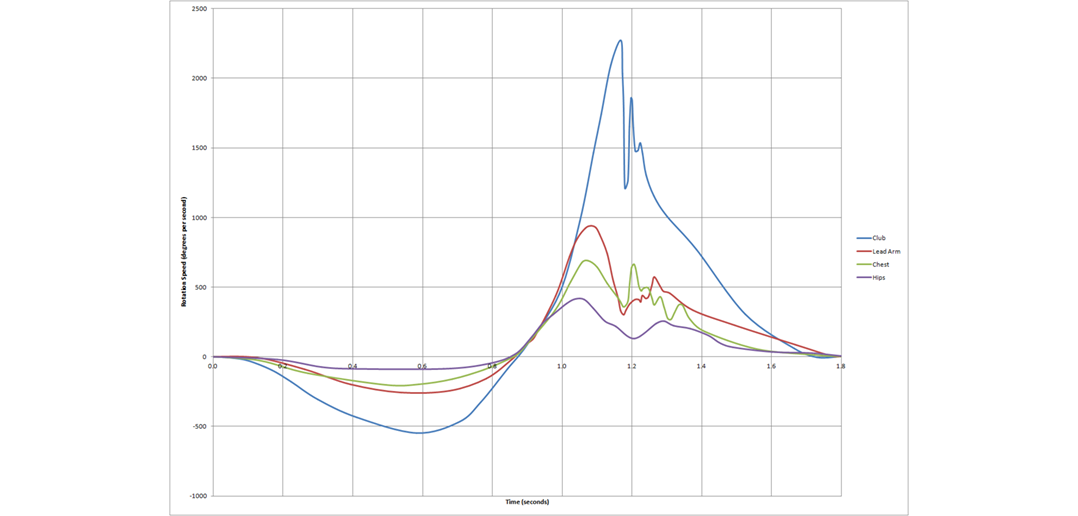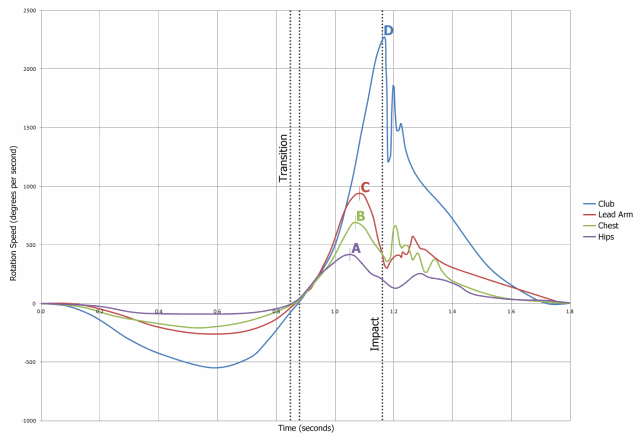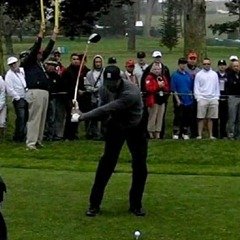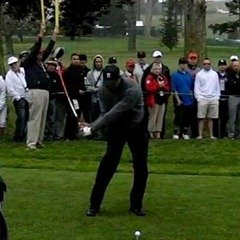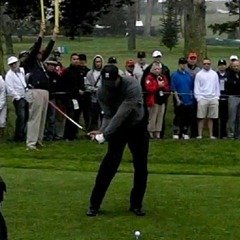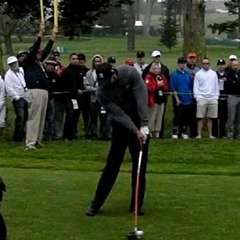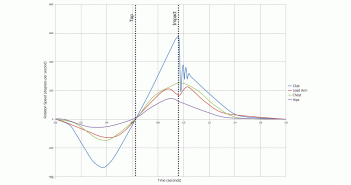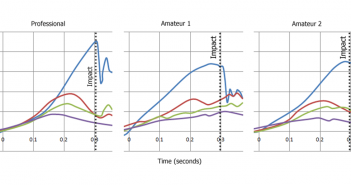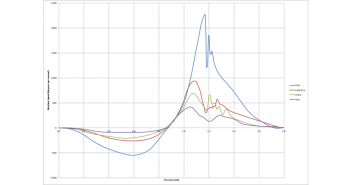We define the downswing phase as the movement from Transition through to Impact — see Figure 1. This whole sequence is completed in less that 3 tenths of a second.
During the golf downswing, each part of your body must accelerate and then decelerate in the correct sequence, with precise and specific timing, so that the club arrives at impact accurately and with maximal speed.
Figure 1. The Golf Swing Kinematic Sequence
The most efficient sequence of motion in the downswing is: hips (pelvis), chest (thorax), arms and finally the golf club. This motion must occur sequentially with each segment reaching speeds that are faster than the previous one, and peaking fractionally later — the peak for each segment in Figure 1 is to the right of the previous one.
Figure 2. Tiger Woods’ downswing.
This sequence creates an efficient transfer of energy across each part of your body, and facilitates a progressive increase in energy from the inner segment to the outer one, from the legs and hips all the way through to the golf club. The larger, inner segments such as the hips and chest move more slowly, with speed building up as the energy progresses to the smaller, outer segments such as the arms, hands and club.
It is vital that you understand that correctly timed and sequenced deceleration is a crucial part of the kinematic sequence in the downswing, it is absolutely necessary to enable the efficient energy transfer along the kinetic chain.
For example, many amateurs make the mistake of rotating their hips hard all the way through to impact, so the energy created by the big muscles in their core isn’t released through to the club until well after impact, if at all. This feels powerful, but all that muscular effort is wasted, all it achieves is a sore back as the hips are forced to decelerate hard in the follow-through!
This deceleration, however, is not a matter of “putting on the brakes”, you don’t consciously slow any part of your body down in the downswing. The energy is conserved, it is not reduced by braking, it is transferred along the kinetic chain to the smaller, outer parts of the body, and so eventually to the club. The deceleration of each segment in turn is caused by the transfer of energy away from that segment to the next in the chain — you may remember this phenomenon from school as the “conservation of angular momentum”.
If the timing and sequencing is correct, the muscles of each joint in the chain produce an increase in energy and then transfer that energy along the chain. If the timing of energy transfer is wrong, energy can be lost and hence speed will be lost. Also, if one part of your body has to compensate because another is not acting correctly, then injury may result.
We can see the timing of this sequence clearly by comparing the graph in Figure 1 with the video of Tiger Woods’ downswing in Figure 2. The pictures of Tiger, below, show the body position at each of the peak rotational speeds on the graph; hips peak (A), chest peak (B), lead arm peak (C), and club peak (D).
This occurs approximately 0.18 seconds into the downswing.
Pay special attention to the early part of the downswing in the graph (Figure 1). The arm speed (red) is actually faster than (on top of) the club speed (blue). This means that the wrist is cocking more just before release, and the club is lagging behind the arms, as you can see here. This enables the efficient use of the “stretch-shorten cycle” of the forearm muscles to supply more energy to the club.
Notice how the hips have hardly moved since A, yet the chest and arms are still rotating rapidly.
Notice how the hips have, again, hardly moved since A, and now the chest has almost stalled since B (you can see this most clearly by looking closely at the position of Tiger’s right shoulder), but the arms are still moving fast.
Notice also that the club has only just started to rotate faster than the arms — the angle between the forearms and the shaft has only just started to open fractionally. Up until this point, the club has been lagging behind the arms.
Impact occurs less that 3 tenths of a second after the top of the backswing, and less than a tenth of a second after the arms start to decelerate at C.
Notice how far the club head has moved compared to the arms since C, as it is released into impact at over 125mph (200 kph).
By impact, the lead upper arm has slowed to less than half its peak speed as its energy is released into the club. It is now moving at the same speed as the chest, which promotes accuracy and consistency.
The video and pictures clearly show that the hips peak first, then the chest, then the arm, and then the club.
The peaks for the hips, chest and arm (A, B, and C) are very close in time, as we can see on the graph, and in the first three pictures where the hands only move about 12” (30cm) in the 0.036 seconds between A and C.
There is a larger interval between the arm peak and the club peak — from C to D is more than twice as long as from A to C — during which the club more than doubles in speed as the combined energy created by the inner segments is released into the club, causing the arm to decelerate.
The club rotational speed should peak just after impact, indeed the graph shows us at D that the club is still accelerating through impact.
The Release
The release is often described in terms of “letting go” of the angle between the forearms and the club. “Letting go” implies that you are “holding on” before the release, that you are using muscular effort to keep the angle between the forearms and the club.
This is completely misleading.
While maintaining the angle between the forearms and the club late into the downswing (or “lagging” the club) is certainly crucial for generating club head speed through impact, it is not a matter of “holding on” to this angle by tensing your muscles. It is more a case of moving in the correct sequence so as not to “throw away” the angle too soon. If you move correctly, you will generate Tour-calibre lag while the hands, wrists and arms remain soft and relaxed.
It is much more instructive to think of the release as releasing the energy that you have generated, with your body, into the club at the right moment, which you achieve by moving your hips, chest and arms in a precise and specifically timed sequence.
The first two thirds of the downswing are spent gradually, sequentially, building energy in your body, before releasing that energy into the club through to impact. Think in terms of smoothly building to a crescendo of speed, first in your torso and then in your lead arm, and then “throwing” that energy out through your hands and into the club through impact.
Instinctively, we all associate power in the golf swing with our shoulders and arms. These are the parts of our body will move the fastest and that are closest to the golf club. Contrary to your instincts, you need to let the power build from the ground up, through your legs, your hips, then your torso. This will feel relatively effortless, compared to firing your arms too soon, as your chest turns much more slowly than your arms — but remember that your torso is large and heavy, so it may move more slowly but it generates a lot of energy (in the form of angular momentum). Until just before point A, your arms will feel passive, that they are just along for the ride and being moved only by gravity. It is not until shortly before A, when your core segments begin to reach peak speed and then decelerate in turn, transferring their energy outwards, that you should feel that you are “pouring on the power” through your arms.
If you rush the sequence, if you try to generate too much power, too soon, you will disrupt the energy transfer and thus lose speed.
There is only one fast move in a great golf swing, and that is when the club strikes the ball.
In order to fully appreciate how lag and the release of the club work, you need to understand that there are two mechanisms for transferring momentum along the kinetic chain.
The first mechanism is inter-segmental transfer of energy due to muscular activity. As we have seen, this is most effective when one segment in the chain turns ahead of the next, stretching the connecting muscles and fibres, and when it has reached maximum velocity the muscles contract. For example; hips to torso, the obliques are stretched as the hips rotate ahead of the torso, and then contract at the point where the hips reach maximum velocity.
The second mechanism, and the most crucial in terms of achieving maximum club head speed, is the energy multiplier due to what is called the “compound pendulum effect”. This amazing phenomenon only works effectively when muscle activity during the downswing is in perfect harmony with the compound pendulum effect. When this happens, through the precisely timed sequence of body movements described above, we see enormous gains in club head speed, swing stability, accuracy and consistency.
The compound pendulum effect explains how lag and the correct release of the club work so effectively, and why the sequence can’t be rushed. It is described in detail in Golf Lag and the Compound Pendulum.
Fixing Faults In Your Own Downswing
As we said at the beginning, you can discover how to learn and ingrain a great golf swing in the Swing like a Champion system, where you will also learn how to identify the specific faults in your own golf swing and remedy them.
The article Golf Swing Sequence and Timing – Common Faults gives a comparison of the kinematic sequence for typical amateurs and Tour Pros, showing the common flaws that may plague your own golf swing.
It is important to understand, however, that the underlying causes of inefficiencies during your downswing are invariably found in the preceding phases of your swing. The best way to fix your downswing is to improve first your address position, then your backswing technique, and finally your transition sequencing. An anatomically correct setup, followed by precisely timed takeaway, backswing and transition sequences, are crucial for a great downswing kinematic sequence.
If you have any questions or comments about this or other articles on Golf Loopy, please send us an email.
Next, see an analysis of the kinematic sequence of the Transition phase in Golf Swing Sequence and Timing – The Transition.
Coming soon: Analysis of the Takeaway and Follow-Through phases.
You May Also Like…
Golf Swing Sequence and Timing – Common Faults, which gives a comparison of the kinematic sequence for typical amateurs and Tour Pros, showing the common flaws that may plague your own golf swing.
Golf Lag and the Compound Pendulum, which describes how you can use physics to generate more speed, accuracy and consistency in your golf swing, with less effort and less strain on your body.
Introduction to the Swing like a Champion System
Overview of a Great Golf Swing, which summarises the correct movements in a great golf swing.
The Role of the Right Arm in the Golf Downswing, which describes how the right arm transfers energy to the golf club in the downswing.
Golf Anatomy and Kinesiology, a collection of articles describing the roles of the muscles involved in the golf swing.
Ground reaction force (GRF), which describes how driving into the ground with your legs transfers power back up through your body.
Kinetic Chain, which describes how the different parts of your body act to transfer energy from the ground to the golf ball.
» The Biomechanics of the Golf Swing.

